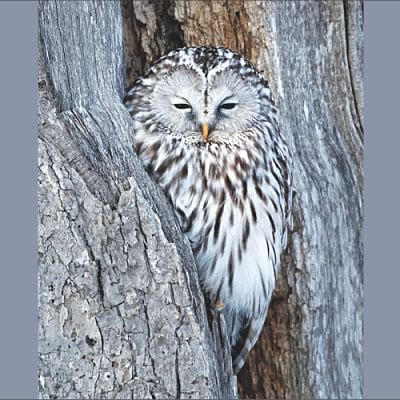Owls

Owls occupy a special place among birds. Nocturnal creatures, they look distinctive because of their large heads and upright stance. They hunt smaller animals such as mice using sharp talons, acute hearing and eyesight, and fast, silent flight. There are about 250 species of owls in the world belonging to the order Strigiformes. They are divided into two families: Tytonidae (owls with a heart-shaped face, such as Barn Owls) and Strigidae (all other owls.)
Since time immemorial, owls have captured our imagination. In some cultures they are considered wise and helpful while in others, primarily because of their nocturnal nature, they are associated with evil. In Shakespeare, the death of Julius Caesar was preceded by an omen: an owl - “a bird of night” - shrieked and hooted in the marketplace “even at noonday.”
For a birder, the owl is captivating because it is so unlike other birds. For example, sometimes an owl will fix me with a long, unsettling stare of its large yellow eyes. If roosting, it will sit in one spot, static for a long time, with both eyes closed. The eyes will open drowsily once in a while to check the surroundings. It might preen its feathers with slow movements, eyes still closed.
The most common owl I have seen in Bangladesh is the Spotted Owlet, known in Bangla as Khuruley Pecha. I saw them in many places, but the National Botanical Garden hosts couples and families in the Teak garden. Once I saw a couple huddling in the rain, their wet, clumped feathers giving them a distinctive alien look.
I have also seen the Asian Barred Owlet, Brown Boobok, Collared Scops Owl and Barn Owl in Bangladesh. The last one was a special encounter. My friend from school days, Tanvir, saw it in his Banani backyard and alerted me. I immediately went over. The roosting Barn Owl perched on a tree at a height of five feet while I photographed it. It remains the only wild bird I have been able to touch and elicit no response – so deep was its sleep.
Overseas, the most memorable owl I saw was the Ural Owl, which we found roosting in a tree in northern Hokkaido. It is a large owl – about two feet tall – with a delicate pattern of grey, brown and white. And on a falconry I visited in Slovakia during winter, I photographed the spectacular Snowy Owl, its head as white as snow.
Like many other birders, if I hear about an (unusual) owl I compulsively search for it. But it is an unpredictable proposition. I failed in my search for a Short-eared Owl in a char in Rajshahi. The large char it was known to inhabit was overrun by small shrubs. After several hours of searching among those shrubs, our team of three finally gave up. The Brown Fish Owl, supposedly easy to find, has also eluded me. Twice in Australia I combed large fields full of trees looking for a Scops Owls without luck.
I am yet to see the majority of the thirteen owl species of Bangladesh. For me, that holds the promise of more excitement in the future.
www.facebook.com/ikabirphotographs or follow ihtishamkabir on Instagram

 For all latest news, follow The Daily Star's Google News channel.
For all latest news, follow The Daily Star's Google News channel. 



Comments